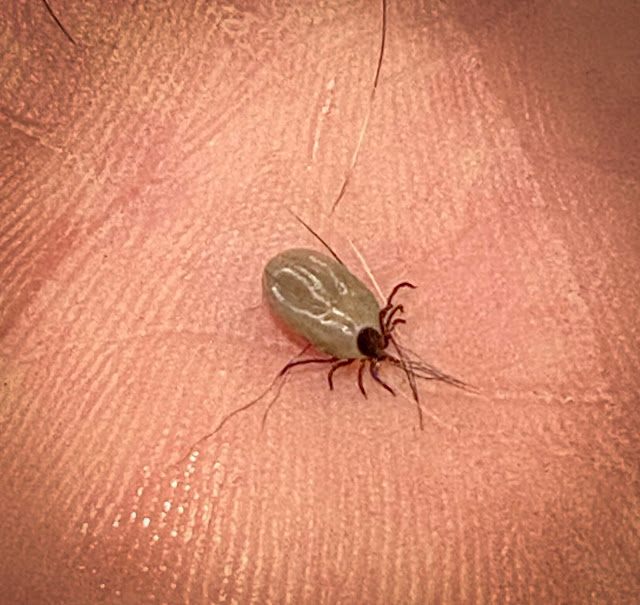Unfortunately, they’re part of the outdoors, and while New Canaan Nature considers them “a strong and important link in the food chain,” I’d personally be happy to see them gone.
But, they're not going anywhere, and thanks to the effects of climate change (warmer winters with less snow), we will keep having "the worst year," over and over. Especially with the fact that ticks can be active any time of year when the temperatures are above freezing.
I think plenty of people are aware of Lyme disease and at least know some of the symptoms, but Lyme is just one of several diseases that can be spread by ticks in New England.
Let's first dive into the different ticks found here in the northeast (data from CDC.gov)
(See pic at further down for comparison of all the different ticks)
Black-Legged Tick (Ixodes scapularis): Also known as the deer tick, the black-legged tick is the primary carrier of Lyme disease in New England. It is a small tick with black legs and a reddish-brown body. The nymphs and adult females are usually responsible for transmitting: Borrelia burgdorferi and B. mayonii (which cause Lyme disease), Anaplasma phagocytophilum (anaplasmosis), B. miyamotoi (hard tick relapsing fever), Ehrlichia muris eauclairensis (ehrlichiosis), Babesia microti (babesiosis), and Powassan virus (Powassan virus disease).
- Lyme disease: Lyme disease is the most prevalent tickborne illness in New England and is primarily transmitted by the black-legged tick (also known as the deer tick). The symptoms of Lyme disease can range from mild to severe and may include fatigue, fever, headache, muscle aches, and may include the characteristic "bull's-eye" rash. Symptoms can occur 3-30 days after tick bite. Blood tests specifically looking for Lyme will often be normal for the first few weeks of an infection, but other lab abnormalities *may* be seen. If left untreated, Lyme disease can lead to complications affecting the joints, heart, and nervous system. There is wide controversy, even among infectious disease specialists regarding "chronic Lyme," and to whether or not there are long term effects and/or if long courses of antibiotics are required.
- Hard Tick Relapsing Fever: Spread by the black-legged tick, this disease can manifest 3 weeks to 6 weeks after a bite and symptoms may be so mild that an infected person wouldn't notice, or could include fever, chills, fatigue, muscle or joint pains and relapsing fevers. This usually resolves on its own but can be severe in people with a compromised immune system.
- Anaplasmosis: Anaplasmosis is caused by the bacterium Anaplasma phagocytophilum, which is also transmitted by the black-legged tick. The symptoms include fever, headache, muscle aches, chills, and fatigue (like many of the other tick diseases), occurring 5-14 days after a bite.
- Ehrlichiosis: Caused by Ehrlichia chaffeensis, E. ewingii or E. muris, this is spread by lone star ticks and black-legged ticks and is similar to anaplasmosis but may also include gastrointestinal symptoms.
- Rocky Mountain spotted fever: RMSF, caused by Rickettsia rickettsii, hasn't been too prevalent in New England, but it's an important disease to be aware of. If not diagnosed early enough, this can be fatal. Spread by the American dog tick, RMSF can cause high fevers, severe headache, fatigue, swelling around the eyes and hands, and then progress to confusion, coma and multi-organ system failure. A spotted rash is common, but is usually a later symptom and is absent in about 10% of cases.
- Tularemia: This can be spread by several species of ticks, and in some cases, but infected deer flies. The CDC does say this is common in some parts of Massachusetts, but that's mostly in Martha's Vineyard. Caused by Francisella tularensis, symptoms (3-5 days after a bite but up to 21 days) can be nonspecific (fever, chills, fatigue), may include gastrointestinal symptoms (vomiting, diarrhea), but may also have a cough, swollen lymph nodes, eye pain, sore throat, and skin ulcerations.
- Babesiosis: Babesiosis is caused by microscopic parasites, Babesia microti, that infect red blood cells. Symptoms starting 1-4 weeks after bite include fever, fatigue, muscle aches, and sometimes anemia. Severe cases can involve a swollen spleen or liver, yellowish skin (jaundice) and lead to severe bleeding abnormalities and death.
- Powassan virus disease: While relatively rare, Powassan virus is a potentially serious tickborne illness found in New England. The virus is transmitted by the black-legged tick and the groundhog tick. Symptoms can range from mild flu-like symptoms to more severe complications, such as inflammation of the brain (encephalitis) or the membranes surrounding the brain and spinal cord (meningitis). There is no specific treatment for Powassan virus, so prevention becomes even more critical.
- Wear protective clothing: When venturing into tick-prone areas, wear long-sleeved shirts, long pants tucked into socks, and closed-toe shoes to minimize skin exposure. Tucking pant legs into socks might work for hikers, but trail runners and mountain bikers, not so much. I *have* been known to wear leggings specifically for summer use--they're designed to cover legs (or arms) and provide protection from the sun and insect. They're certainly a fashion statement, but if you know me, you know fashion isn't high on my priority list.
- Use insect repellents: Apply Environmental Protection Agency (EPA)-approved insect repellents containing DEET, picaridin, or IR3535 to exposed skin and clothing. You can also use permethrin on clothes (either spray on yourself or buy clothes with this already in the fabric).
- Perform tick checks: After spending time outdoors, thoroughly check your body and clothing for ticks. Pay extra attention to hidden areas such as underarms, groin, scalp, and behind the knees.
- Seek medical attention: If you develop symptoms consistent with tickborne diseases, seek medical attention promptly. Early diagnosis and treatment can help prevent complications.
















No comments:
Post a Comment